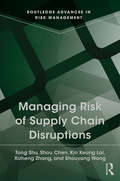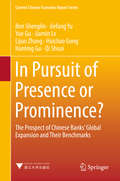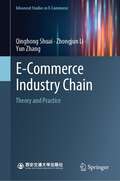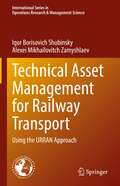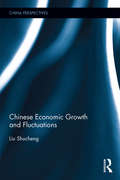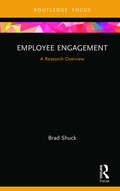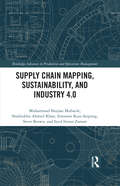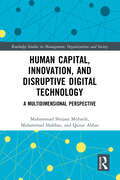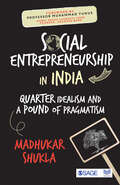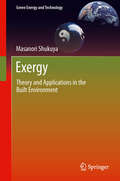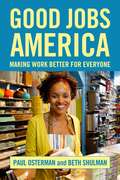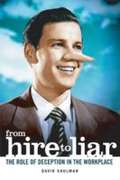- Table View
- List View
Summit Partners: Independent Vetcare
by Terrence Shu Victoria IvashinaThis case follows Summit Partners, a leading growth equity firm, as it evaluates an investment opportunity in IVC, a veterinary care group in the U.K. market. The case allows students to articulate and evaluate the investment thesis of this transaction. Additionally, it provides insight into the sourcing and due diligence process in the modern growth equity space, as well as details of the financial structure of the investment. In particular, the case provides students with an opportunity to recreate the valuation model, and understand the economics of the preferred equity. The case can be used as a platform to reflect on the value add of growth equity investors and what constitutes as a "propriety" investment in the mature growth equity industry.
Managing Risk of Supply Chain Disruptions (Routledge Advances In Risk Management Ser.)
by Tong Shu Shou Chen Kin Keung Lai Xizheng Zhang Shouyang WangThis book discusses important issues related to managing supply chain disruption risks from various perspectives. It explores the essence and principles relating to managing these risks and provides the framework and multi-goal model groups for managing such risks. The book also discusses research development of managing supply chain disruptive risks, supply chain risk conduction and loss assessment methods of supply chain disruptive events. It also includes the consideration of supply chain coordinating models in the cases of demand and supply disruption risks. It also deals on the subject of managing models of supply chain disruption risks by looking at manufacturers and responding decision methods oriented towards demand in disruption and coordination. It also summarizes the relevant findings and provides future research questions and orientations. The book will contributes significantly to the growing body of knowledge concerning the theory of managing supply chains.
In Pursuit of Presence or Prominence?: The Prospect Of Chinese Banks' Global Expansion And Their Benchmarks (Current Chinese Economic Report Ser.)
by Qi Shuai Hanting Gu Huichao Gong Lijun Zhang Jiamin Lv Yue Gu Jiefang Yu Shenglin BenThis book summarizes Chinese banks’ achievements in global markets and examines the differences between Chinese and foreign banks. It also explores the future roadmap of internationalization and the risks involved in the process, in order to provide reference resource for Chinese banks.Based on the CBII (Chinese Bank Internationalization Index), which was first released in 2015, the book introduces the Banks’ Internationalization Index (“BII”) and expands the BII by examining two groups of data, including the number of overseas branches, overseas assets and revenue. In addition it analyzes representative Chinese banks’ internationalization, using 16 of the Global Systemically Important Banks (G-SIBs) as benchmarks.
E-Commerce Industry Chain: Theory and Practice (Advanced Studies in E-Commerce)
by Qinghong Shuai Zhongjun Li Yun ZhangThis book focuses on e-commerce industry chain based on the whole process of e-commerce activities (production, distribution, circulation, consumption). It extracted the supporting technology and operation process of e-commerce into general principles in the form of mathematical analysis, helping readers to build the frame of theory and practice of activity link of e-commerce. This book stands on the concepts, carries on the innovation and cases in the practice, helping readers to establish a relatively complete e-commerce system. Also the arising challenges and issues are discussed, and guide for the future e-commerce development under the new situation is presented.
Technical Asset Management for Railway Transport: Using the URRAN Approach (International Series in Operations Research & Management Science #322)
by Igor Borisovich Shubinsky Alexei Mikhailovitch ZamyshlaevThis book introduces readers to the key provisions of the URRAN-based technical asset management system - a methodology for managing resources and risks by analyzing and ensuring the required levels of reliability and safety in Russia’s railway transport facilities. It describes the architecture of the URRAN information system’s unified corporate platform (UCP URRAN) and its subsystems for infrastructure facilities and rolling stock complexes. It also highlights the UCP URRAN’s prospects for development, especially in the application of artificial intelligence to predict dangerous events in railway transport operation. The book is chiefly intended for specialists engaged in practical work on the technical maintenance of railway transport facilities. It can also be used as a reference guide for students and researchers at railway universities or professionals who are dealing with problems in technical asset management in other industries.
Chinese Economic Growth and Fluctuations (China Perspectives)
by Liu ShuchengSince the economic reform of the 1980s, Chinese economy has boomed and has now become the second largest in the world. Based on the constant and systematic researches of economic periodicity, this book studies Chinese economic growth and fluctuations. As a famous Chinese economist, the author is the first one who demonstrated the investment periodicity in China. His groundbreaking studies on Chinese economic periodic fluctuation have significant impact at home and abroad. The first six papers collected in this book mainly examine issues on Chinese periodic fluctuation and macroeconomic regulation, including the periodic fluctuations from 1953 to 1994, and a comparative analysis of five macroeconomic regulations since the reform and open up in the late 1980s. The last seven papers appear in the author's collected works for the first time. They are focused on the new characteristics of Chinese macroeconomic operation and regulation after the financial crisis of 2007-2008. In addition, this book reviews on China's economic growth from 1949 to 2009 and provides some valuable suggestions on how to maintain the rising trend of the new economic cycle.
Chinese Macroeconomic Operation (China Perspectives)
by Liu ShuchengLiu Shucheng is a famous Chinese economist who has a major impact on the study of China's macroeconomics and quantitative economics. Selecting some of Liu's representative studies on Chinese macroeconomy, this book will be a valuable reference for understanding and studying Chinese economy. The first five papers appear in the author's collected works for the first time. They mainly study the overall balance of Chinese macroeconomic operation and the relative economic mathematical models. The commodity-currency balance sheet improved the earliest input-output model introduced to China in the 1980s, and the author's frontier research is of great importance for Chinese economic study. In attempting to solve the problems caused by incontrollable fixed assets investment, the author examines the periodicity of fixed assets investment in China, including the characteristics, causes, and the impact of investment periodic fluctuation on economic periodic fluctuation. Besides, the author studies Phillips curves in China in a comprehensive and intensive way. These in-depth analysis provide original insights based on the author's extensive research.
Employee Engagement: A Research Overview (State of the Art in Business Research)
by Brad ShuckThe field of employee engagement has experienced unprecedented growth over the last three decades. Despite remarkable progress in both practice and scholarship, there remains tremendous confusion about what employee engagement is, what it means, and how organizations can take proactive steps to harness the full power of an engaged workforce. This short-form book provides readers a unique and research-based road map through the rapidly evolving research around employee engagement, including the identification of key literature and theory along with expert, timesaving connections to how theory has informed practice. The author covers the various disciplinary approaches and schools of thought, thematically bridging scholarly literature – including and identifying the historically significant and most current – to better understand how the research is evolving and what new opportunities for scholarship are emerging. Essential reading for scholars of human resource management, leadership and management more broadly, the book is also a valuable read for reflective practitioners globally.
Rural Transformations and Rural Policies in the US and UK (Routledge Studies in Development and Society)
by Mark Shucksmith David L. Brown Sally Shortall Jo Vergunst Mildred E. WarnerThis book examines the transformations of rural society and economy in the UK and US during the last half-century, and explores the significance of these trends and changes for community sustainability, quality of life and the environment. While both the UK and US are highly urbanised, rural people and communities continue to contribute to national identity, economic development and social solidarity, as well as to environmental quality. Contributors explore the degree to which rural people exhibit agency and autonomy, rather than being merely passive in the face of exogenous forces of change in a globalised world. They also illuminate very different policy approaches to rural policy in two advanced capitalist societies often thought to be similar, and show how fundamental differences in rural policy approaches of the US and the UK are based on different social ideologies and values that shape policies relating to rural areas. This book will help to stimulate transatlantic dialogue on rural scholarship and rural policy analysis, while also contributing to theory and policy development. It will be of interest to researchers, students and everyone involved in the policy and practice of rural development.
Paying for Progress in China: Public Finance, Human Welfare and Changing Patterns of Inequality (Routledge Contemporary China Series #Vol. 21)
by Vivienne Shue Christine WongChina’s stunning record of economic development since the 1970s has been marred by an increasingly obvious gap between the country’s ‘haves’ and its ‘have-nots’. While people living in some parts of the country have enjoyed dramatically improved conditions of life, those in other districts and regions have slipped ever further behind in terms of access to health, wealth, education, security and opportunity. Paying for Progress in China is a collection of essays which trace the causes of this growing inequality, using new data including surveys, interviews, newly available official statistics and in-depth fieldwork. Their findings expose the malfunctioning of China’s ‘broken’ intergovernmental fiscal system, which has exacerbated the disequalizing effects of emerging market forces. Whilst the government’s deliberately ‘pro-poor’ development policies have in recent years sought to reduce the gap between rich and poor, both markets, and also state institutions and policies, are continuing to create perverse equity outcomes across the country, confounding hopes for better-balanced and more inclusive growth in China. The interdisciplinary approach of this collection, incorporating work by economists, sociologists and political scientists, makes it a valuable resource for students of contemporary Chinese political economy and social development.
Web 2.0. Przewodnik po strategiach
by Amy ShuenPoznaj strategie i modele biznesowe, które podnios? wyniki finansowe Twojej firmy! Jak zarabia?, dostarczaj?c us?ugi za darmo?Jak stworzy? dochodowy biznes, oparty na Web 2.0?Jak w??czy? strategie Web 2.0 w istniej?ce przedsi?wzi?cie?Je?li my?lisz, ?e Web 2.0 to wy??cznie technologia budowy interaktywnych portali internetowych, jeste? w b??dzie. Web 2.0 to rewolucja! To nowy sposób komunikacji przez internet, umo?liwiaj?cy u?ytkownikom wspólne tworzenie witryny i dzielenie si? wiedz?. Dzi?ki efektom sieci Web 2.0 staje si? ?ród?em okazji biznesowych. Jest miejscem, gdzie zaawansowana technologia ??czy si? z biznesem i gdzie -- udost?pniaj?c us?ugi za darmo -- mo?esz zarabia?. Web 2.0 przyjmuje bowiem fundamentalnie odmienny punkt widzenia na relacje mi?dzy biznesem, klientami i partnerami, a wi?c udost?pnia nam wszystkim nowe modele biznesowe. Ksi??ka "Web 2.0. Przewodnik po strategiach" zawiera omówienie wszystkich potrzebnych w biznesie technik i narz?dzi analitycznych, co sk?ada si? na ogólny obraz ekonomii opartej na Web 2.0. Z tego podr?cznika dowiesz si?, jak powstaj? efekty sieci, w jaki sposób prowokowa? i wykorzystywa? okazje biznesowe oraz zarabia? pieni?dze na dostarczonych przez u?ytkowników warto?ciach. Uwierzysz, ?e za pomoc? Web 2.0 mog? bogaci? si? i korporacje, i niewielkie przedsi?biorstwa. Poznasz sprawdzone narz?dzia i strategie oraz rewolucyjne modele biznesowe, stosowane przez takie firmy, jak Google czy Amazon. Pami?taj, ?e tym firmom przynios?y one wielki sukces i ogromne zyski.Wspólna warto?? u?ytkowników portalu Odkrywanie i wykorzystywanie grup internetowychPozytywne efekty sieciowe w Web 2.0Spieni??anie sieci spo?ecznychKoszty pozyskania klienta i szybko?? wzrostu zysku z reklamTworzenie warto?ci w sieciach spo?ecznychRozwijanie zdolno?ci adaptacyjnych przez Web 2.0Style innowacjiTworzenie biznesplanów Web 2.0 Przy??cz si? do rewolucji Web 2.0 i zarabiaj w internecie Wyró?nienie Magazynu Literackiego KSI??KIRedakcja Magazynu Literackiego KSI??KI przyzna?a ksi??ce "Web 2.0 - przewodnik po strategiach" w kwietniu 2009 roku Wyró?nienie za ksi??k? miesi?ca w kategorii Ekonomia http://helion.pl/img/rozne/wyd/wyd7_6.jpg" />
Taxing Choice: The Predatory Politics of Fiscal Discrimination
by William Shughart IITaxing behavior deemed "politically incorrect" has long been a convenient way for politicians to fund programs benefiting special interest groups, to the public's disadvantage. Government policy toward various goods - drugs, tobacco and alcohol, for example - has been locked into a regulatory cycle of tax and taboo. Support for legalizing other substances is buttressed by the revenue-generating power of so-called "sin" taxesi And the products subjected to excise taxation have varied from soft drinks, fishing gear and margarine to airline tickets, telephone calls and gasoline. Taxing Choice thoroughly addresses the costs and benefits of these predatory public policies.Shughart notes that the record of such punitive selective taxation has been anything but successful, hindering economic progress and failing to deliver the promised social benefits. In addition, the costs of selective taxes fall disproportionately on lower-income people, while more politically powerful interest groups benefit. At the same time, such policies are a poor way to raise funding for public services, and foster political corruption and self-serving bureaucracies accountable to no one. Indeed, policies discriminating against certain products may represent ominous trends easily extended into virtually every facet of people's lives. One can envision policies proscribing foods, sun bathing, obesity, and even books, films, and political and religious beliefs deemed "dangerous."Part I is devoted to the political economy of selective taxation. Contributors trace the history and politics of selective excise taxes in the United States, discussing the range of products that have been subject to such taxation from the founding period to the present. Part II explains how these taxes emerge in a political marketplace with opposing pressure groups scrambling for wealth transfers in their own favor. Part III looks at taxes on specific products as well as such banning policies as Prohibition and the war on drugs. Constitutional, economic, and civil liberty issues, including civil asset forfeiture and product liability, are discussed in Part IV. With the accelerating national debate over tax reform and the downsizing of government, Taxing Choice is a timely and far-reaching contribution to a debate of great interest to economists, policymakers, historians, sociologists, and taxpayers in general.
Supply Chain Mapping, Sustainability, and Industry 4.0 (Routledge Advances in Production and Operations Management)
by Muhammad Shujaat Mubarik Sharfuddin Ahmed Khan Simonov Kusi-Sarpong Steve Brown Syed Imran ZamanDuring the COVID-19 pandemic, supply chain (SC) mapping appeared as one of the critical SC capabilities that could make a striking difference in organizations’ SC performance and improve sustainable operations. Despite its crucial role in responding to SC disruptions, there is a void in the literature on this topic. This book aims to address this gap demonstrating the importance of SC mapping, sustainability in the Industry 4.0 era. The book explores how SC mapping contributes to sustainability from social, economic, and environmental perspectives, the role of SC mapping in upstream, midstream, and downstream SC sustainability, as well as the role of technology advancement and the impact of blockchain and Industry 4.0 in SC mapping. Adopting a multidisciplinary approach, this edited collection features international authors from a diverse range of disciplines including SC management, operations management, technology and innovation management, and sustainability. The book will be a valuable resource for global scholars, researchers, and upper-level students across operations, SC management, and logistics, as well as engineering and technology management.
Human Capital, Innovation and Disruptive Digital Technology: A Multidimensional Perspective (Routledge Studies in Management, Organizations and Society)
by Muhammad Shujaat Mubarik Muhammad Shahbaz Qaisar AbbasHuman capital appears to be at the core of business strategies helping firms to recover from the catastrophic effects of COVID19 and bounce back effectively. The book in hand provides a diverse view of the human capital, its multifaceted role and application in an organization. The book also offers a comprehensive analysis on the role of human capital in industry 4.0, firm internationalization, and organizational ambidexterity and outlines strategies for the firm to improve its human capital readiness, keeping in view the contemporary business dynamics. A very simple and focused approach has been adopted through the book to make it readable for the people from the diverse fields. The book also focuses upon the conceptualizations and measurements of human capital in order to offer conceptual clarity of human capital to readers. A central focus of the book is how human capital interacts with and complements other organizational resources and technological developments. The book will be extremely useful for top-tier managers, researchers, academicians, consultants, and practitioners interested in gaining a current, relevant, and diverse perspective on human capital, its dimensions, and development.
Developing Senior Navy Leaders
by Herbert J. Shukiar Lawrence M. Hanser Bruce Newsome Louis W. MillerCould U.S. Navy officers be better prepared to become flag officers? This study examines the kinds of expertise required for successful performance in Navy flag billets, and whether recent pools of officers possess this experience. The authors also examine Navy trends over the past decade to identify the types of expertise likely to become more important for Navy leaders in the future.
Backchannelmedia: Making Television 'Clickable'
by Kavita Shukla Sunil Gupta Zach ClaytonBackchannelmedia (BCM), a three year old start-up, intended to completely disrupt the world of advertising by transforming the way Americans watched television. BCM had developed a technology to make television "clickable," enabling viewers to interact with the content on their television screens. By April 2009, BCM had conducted consumer studies and field tests and the results were very promising. However, the industry was dominated by large players who could impede the introductions of new technologies. BCM's founders would have to make critical decisions about how quickly to roll-out their technology, and to whom. Which industry players were allies? How would BCM monetize the value they would create? Would investors see as much potential in BCM as its founders? And how would the company's cash constraints impact the strategy in the current economic environment?
Backchannelmedia: Making Television 'Clickable'
by Kavita Shukla Sunil Gupta Zach ClaytonBackchannelmedia (BCM), a three year old start-up, intended to completely disrupt the world of advertising by transforming the way Americans watched television. BCM had developed a technology to make television "clickable," enabling viewers to interact with the content on their television screens. By April 2009, BCM had conducted consumer studies and field tests and the results were very promising. However, the industry was dominated by large players who could impede the introductions of new technologies. BCM's founders would have to make critical decisions about how quickly to roll-out their technology, and to whom. Which industry players were allies? How would BCM monetize the value they would create? Would investors see as much potential in BCM as its founders? And how would the company's cash constraints impact the strategy in the current economic environment?
Social Entrepreneurship in India: Quarter Idealism and a Pound of Pragmatism
by Madhukar ShuklaWhile the phrase ‘Social Entrepreneurship’ sounds oxymoronic, it certainly is not an unfamiliar concept in the Indian market and society. India is a hub of social entrepreneurship and has a long history of doing business for social causes. The business giants like Amul, Aravind Eyecare, Lijjat, Sulabh Shauchalay, etc. have been solving social problems through entrepreneurial strategies since ages. Inspired by tech giants like Uber or Paytm, aspiring entrepreneurs are looking for problems that can be solved through new business ideas. The emergence of social entrepreneurship as an identifiable sector and as a discipline/field of study has become a social phenomenon. The book starts with tracing the historical roots and the milestone which have led to the recent emergence of social entrepreneurship as a recognized sector of practice and study. Rather than fitting ‘social entrepreneurs’ in a box, it identifies the qualities and patterns of successful social entrepreneurs, both as a person and how they function. Sifting through these diverse approaches to solve social problems, it proposes five broad but distinct types of Indian social entrepreneurs. It describes how social entrepreneurs, like any other entrepreneur, identify opportunities and gaps in the ‘market’, develop innovative solutions to address those problems, and use entrepreneurial strategies to build and scale their ventures.It also discuss the key problems of access to basic social goods (e.g., education, healthcare, credit, etc.) by the poor segment of Indian society, the challenges in servicing this segment and successful entrepreneurial models which social entrepreneurs use to impact their lives. As scaling the impact is an essential requirement for the social entrepreneurs to make a difference in the society and lives of people, the book also discusses three different ways in which social entrepreneurs scale, and the prerequisites and challenges in scaling.
Professional Communication
by Shikha ShuklaTechnical communications, constituents of technical written communications, their forms and presentation strategies are explained in detail in this volume.
Exergy
by Masanori ShukuyaMany people, professionals and non-professionals alike, recognize that it is of critical importance to solve global energy and environmental issues. For this purpose, it is essential to have a scientific understanding of what is meant by the "energy" issue is and the "environmental" issue. The concept of "exergy" is a scientific concept that exactly fits. The concept of 'energy' is a scientifically-well established concept, namely 'to be conserved'. Then the question is what is really consumed. Exergy: Theory and Applications in the Built Environment is dedicated to answer this fundamental question by discussing the theory of "exergy" and by demonstrating its use extensively to describe a variety of systems in particular for built-environmental conditioning. Our immediate environmental space works within the flow of energy and matter in an "exergy-entropy" process, and the built environment can be designed with these energy & environmental issues in mind. Exergy: Theory and Applications in the Built Environment introduces readers who are not familiar with thermodynamics to the concept of exergy with a variety of discussion on the built-environmental space such as heating, cooling, lighting, and others. Readers, including students, researchers, planners, architects and engineers, will obtain a better picture of a sustainable built-environment.
The Betrayal of Work
by Beth ShulmanFollowing its publication in hardcover, the critically acclaimed Betrayal of Work became one of the most influential policy books about economic life in America; it was discussed in the pages of Newsweek, Business Week, Fortune, the Washington Post, Newsday, and USA Today, as well as in public policy journals and in broadcast interviews, including a one-on-one with Bill Moyers on PBS's NOW. The American Prospect's James K. Galbraith's praise was typical: "Shulman's slim and graceful book is a model combination of compelling portraiture, common sense, and understated conviction."Beth Shulman's powerfully argued book offers a full program to address the injustice faced by the 30 million Americans who work full time but do not make a living wage. As the influential Harvard Business School newsletter put it, Shulman "specifically outlines how structural changes in the economy may be achieved, thus expanding opportunities for all Americans." This edition includes a new afterword that intervenes in the post-election debate by arguing that low-wage work is an urgent moral issue of our time.
Good Jobs America
by Beth Shulman Paul OstermanAmerica confronts a jobs crisis that has two faces. The first is obvious when we read the newspapers or talk with our friends and neighbors: there are simply not enough jobs to go around. The second jobs crisis is more subtle but no less serious: far too many jobs fall below the standard that most Americans would consider decent work. A quarter of working adults are trapped in jobs that do not provide living wages, health insurance, or much hope of upward mobility. The problem spans all races and ethnic groups and includes both native-born Americans and immigrants. But Good Jobs America provides examples from industries ranging from food services and retail to manufacturing and hospitals to demonstrate that bad jobs can be made into good ones. Paul Osterman and Beth Shulman make a rigorous argument that by enacting policies to help employers improve job quality we can create better jobs, and futures, for all workers. Good Jobs America dispels several myths about low-wage work and job quality. The book demonstrates that mobility out of the low-wage market is a chimera—far too many adults remain trapped in poor-quality jobs. Osterman and Shulman show that while education and training are important, policies aimed at improving earnings equality are essential to lifting workers out of poverty. The book also demolishes the myth that such policies would slow economic growth. The experiences of countries such as France, Germany, and the Netherlands, show that it is possible to mandate higher job standards while remaining competitive in international markets. Good Jobs America shows that both government and the firms that hire low-wage workers have important roles to play in improving the quality of low-wage jobs. Enforcement agencies might bolster the effectiveness of existing regulations by exerting pressure on parent companies, enabling effects to trickle down to the subsidiaries and sub-contractors where low-wage jobs are located. States like New York have already demonstrated that involving community and advocacy groups—such as immigrant rights organizations, social services agencies, and unions—in the enforcement process helps decrease workplace violations. And since better jobs reduce turnover and improve performance, career ladder programs within firms help create positions employees can aspire to. But in order for ladder programs to work, firms must also provide higher rungs—the career advancement opportunities workers need to get ahead. Low-wage employment occupies a significant share of the American labor market, but most of these jobs offer little and lead nowhere. Good Jobs America reappraises what we know about job quality and low-wage employment and makes a powerful argument for our obligation to help the most vulnerable workers. A core principle of U.S. society is that good jobs be made accessible to all. This book proposes that such a goal is possible if we are committed to realizing it.
From Hire to Liar: The Role of Deception in the Workplace
by David ShulmanThis book offers a sociological study of the rationales for, and methods of, workplace deception. The author begins by presenting an ethnographic analysis of private detectives' routine use of deception as an officially-sanctioned component of their work. He then uses interviews and case-studies to show how similar strategies are used in a variety of other work environments. The author discusses the justification and effects of workplace deception on both workers and employers.
AnswerDash (Abridged)
by Jeffrey D. Shulman Elie OfekIt is 2014 and AnswerDash, a startup backed by venture capital, has not seen the widespread adoption of their online self-service customer support solution that they were expecting based on early success in helping clients save and generate substantial amounts of money. Dr. Jacob O. Wobbrock and Dr. Andrew J. Ko are revisiting their go to market strategy to determine how to build a viable business out of their groundbreaking technology. The case raises issues in entrepreneurship and B2B marketing such as analyzing economic value to the customer, designing optimal price metrics, aligning pricing with marketing strategy, customer life-time value, organizational selling, and influencing innovation adoption.
Competing on Capabilities: The New Rules of Corporate Strategy
by Lawrence E. Shulman Philip Evans George Stalk Jr.In today's dynamic business environment, strategy too must become dynamic. The essence of strategy is not the structure of a company's products but the dynamics of its behavior. To succeed, a company must weave its key business processes into hard-to-imitate strategic capabilities that distinguish it from its competitors. A capability is a set of business processes understood strategically. While such capabilities are collective and cross-functional, they must be built and managed by the CEO. Uses examples from Wal-Mart.

